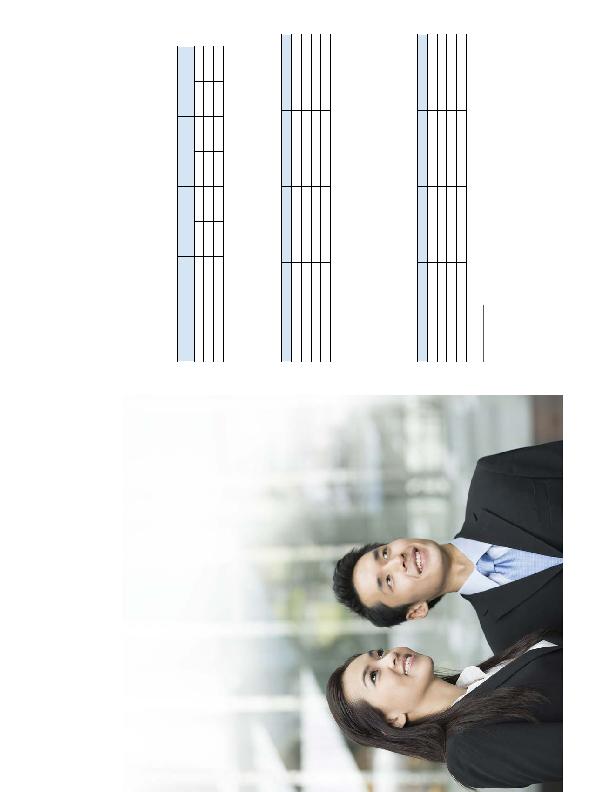
APPENDIX A: SNAPSHOT OF THE CHINESE AMERICAN
COMMUNITY TODAY
With an immigration history that spans more than 150 years, the Chinese American population in the Bay Area is
large and diverse. Table 1 shows that the proportion of Chinese Americans born in the United States is similar to
that of the Chinese Americans in the United States and California as a whole. The proportion of foreign-born Chinese
Americans in the Bay Area who are naturalized U.S. citizens is somewhat larger than that of the Chinese Americans
in United States overall, and slightly larger than that of the state of California.
8
Table 1: Place of Birth and Citizenship Status of Chinese Americans, by Place of Residence, 2010
Status
United States
(n=3,873,730)
California (n=1,400,867)
Bay Area (n=613,657)
Born in the United States
1,503,769
38.8%
540,326
38.6%
235,110
38.3%
Foreign born; naturalized U.S. citizen
1,413,236
36.5%
586,355
41.9%
263,928
43.0%
Foreign born; not a U.S. citizen
956,725
24.7%
274,186
19.6%
114,619
18.7%
Source: 2006-2010 American Community Survey, U.S. Census Bureau
Table 2 shows that foreign-born Chinese American Bay Area residents are somewhat more likely to have arrived
before 1990 (49.8%), compared to the U.S. overall (41.8%). A small number (2-3%) of Chinese American in any place
of residence report that they were living outside of the United States in the previous year.
Table 2: Year of Arrival in the U.S. of Foreign-Born Chinese Americans, by Place of Residence, 2010
Year of Arrival
United States (n=2,421,191)
California (n=877,654)
Bay Area (n=385,955)
Entered 2000 or later
29.6%
22.9%
22.0%
Entered 1990 to 1999
28.6%
27.3%
28.2%
Entered 1980 to 1989
24.0%
28.6%
28.1%
Entered before 1980
17.8%
21.3%
21.7%
Source: 2006-2010 American Community Survey, U.S. Census Bureau
A quarter of foreign-born Chinese Americans in the U.S. were born in non-Chinese countries, while only one in 12
was born in Hong Kong. In the Bay Area, the number born in non-Chinese countries is two-thirds of the U.S. number,
while the number born in Hong Kong is 50 percent more. More than half of the foreign-born population nationally was
born in Mainland China, and slightly more than that in the Bay Area (Table 3). In 2010, half of the population of the
Bay Area of any ethnicity or race spoke a second language at home. Of those, 15 percent speak a Chinese dialect,
second only to Spanish.
Table 3: Place of Birth of Foreign-Born Chinese Americans, by Place of Residence, 2010
Place of Birth
United States (n=2,639,906)
California (n=860,532)
Bay Area (n=378,547)
Mainland China
53.6%
49.9%
57.4%
Taiwan
13.4%
19.0%
14.0%
Hong Kong
7.9%
10.6%
12.2%
Other Country
25.1%
20.6%
16.4%
Source: 2006-2010 American Community Survey, U.S. Census Bureau
8
This information in this box is drawn from the American Community Survey, a sample survey study conducted by the United States Census Bureau. The survey allows people to iden-
tify themselves as having Chinese ancestry alone or in combination with other ancestries or races. The present study focused on five counties of the greater San Francisco Bay Area:
Alameda, Contra Costa, San Francisco, San Mateo and Santa Clara. Contra Costa County was not sampled in the latest wave of the American Community Survey (2011); the most
recent data set that includes all five counties is 2006-2010. At that time, the number of self-identified Chinese Americans (alone or in combination) was 3.9 million nationally. Although
that number has increased since then (to 4.2 million in 2011), the older data set is used in this analysis in order to have comparable data for all five counties, the state and the country
as a whole. The data have been converted to percentages, the relative values of which are unlikely to have changed significantly in the intervening few years. For simplicity, the five
counties together will be referred to as "the Bay Area" in this document.
9
Joint Venture Silicon Valley and Silicon Valley Community Foundation (2012). Index of Silicon Valley. San Jose, CA: Joint Venture Silicon Valley. Page 6.
PARTICIPANTS
The LTG team wishes to thank all of those individuals who gave generously of their time, vision, and wisdom.
Those who agreed to allow their names to be shared are listed below.
Darren Chan
Richard Chen
Mike Cheng
Amy Chung
Ted W. Dang
Jeffrey Gee
Robert and Lily Huang
Theodore Kuh
Hsing Kung
Kathy Kwan
Francis Lee
Robert Lee
Jeremy Liew
Peter Liu
Wade Loo
Lawrence Low
Anna Mok
Leslie Tang Schilling
Anthony Sun
Joshua To
Justin To
Connie Young Yu
Gerrye Wong
ACKNOWLEDGEMENTS
This work was supported by the joint efforts of the Silicon Valley Community Foundation (SVCF) and the Chinese
American Community Foundation (CACF). Both Foundations provided funding and outreach support for the project.
The LTG Associates project team included: Pamela Rao, Ph.D., Project Coordinator; Cathleen Crain, M.A., Project
Monitor; Nathaniel Tashima, Ph.D., Senior Research Associate; and Karen Ito, Ph.D. Senior Research Associate.
Marilyn Anderson provided material support to the team.
The team wishes to especially acknowledge all of the participants who gave their time and wisdom to the study.
Participants were particularly generous in sharing their vision of bettering the world, often with great joy and
optimism.
SILICON VALLEY COMMUNITY FOUNDATION
33
32
SILICON VALLEY COMMUNITY FOUNDATION
